+ Open data
Open data
- Basic information
Basic information
| Entry | Database: PDB / ID: 1k5j | ||||||
|---|---|---|---|---|---|---|---|
| Title | The Crystal Structure of Nucleoplasmin-Core | ||||||
 Components Components | Nucleoplasmin Core | ||||||
 Keywords Keywords |  CHAPERONE / CHAPERONE /  beta-barrel / jellyroll / beta-bulge / beta-barrel / jellyroll / beta-bulge /  pentamer pentamer | ||||||
| Function / homology |  Function and homology information Function and homology informationsperm DNA decondensation / histone chaperone activity / importin-alpha family protein binding /  nucleosome binding / nucleosome binding /  nucleoplasm nucleoplasmSimilarity search - Function | ||||||
| Biological species |  Xenopus laevis (African clawed frog) Xenopus laevis (African clawed frog) | ||||||
| Method |  X-RAY DIFFRACTION / X-RAY DIFFRACTION /  SYNCHROTRON / SYNCHROTRON /  MAD / Resolution: 2.3 Å MAD / Resolution: 2.3 Å | ||||||
 Authors Authors | Dutta, S. / Akey, I.V. / Dingwall, C. / Hartman, K.L. / Laue, T. / Nolte, R.T. / Head, J.F. / Akey, C.W. | ||||||
 Citation Citation |  Journal: Mol.Cell / Year: 2001 Journal: Mol.Cell / Year: 2001Title: The crystal structure of nucleoplasmin-core: implications for histone binding and nucleosome assembly. Authors: Dutta, S. / Akey, I.V. / Dingwall, C. / Hartman, K.L. / Laue, T. / Nolte, R.T. / Head, J.F. / Akey, C.W. | ||||||
| History |
|
- Structure visualization
Structure visualization
| Structure viewer | Molecule:  Molmil Molmil Jmol/JSmol Jmol/JSmol |
|---|
- Downloads & links
Downloads & links
- Download
Download
| PDBx/mmCIF format |  1k5j.cif.gz 1k5j.cif.gz | 101 KB | Display |  PDBx/mmCIF format PDBx/mmCIF format |
|---|---|---|---|---|
| PDB format |  pdb1k5j.ent.gz pdb1k5j.ent.gz | 77.6 KB | Display |  PDB format PDB format |
| PDBx/mmJSON format |  1k5j.json.gz 1k5j.json.gz | Tree view |  PDBx/mmJSON format PDBx/mmJSON format | |
| Others |  Other downloads Other downloads |
-Validation report
| Arichive directory |  https://data.pdbj.org/pub/pdb/validation_reports/k5/1k5j https://data.pdbj.org/pub/pdb/validation_reports/k5/1k5j ftp://data.pdbj.org/pub/pdb/validation_reports/k5/1k5j ftp://data.pdbj.org/pub/pdb/validation_reports/k5/1k5j | HTTPS FTP |
|---|
-Related structure data
| Similar structure data |
|---|
- Links
Links
- Assembly
Assembly
| Deposited unit | 
| ||||||||
|---|---|---|---|---|---|---|---|---|---|
| 1 |
| ||||||||
| Unit cell |
|
- Components
Components
| #1: Protein | Mass: 13752.683 Da / Num. of mol.: 5 / Fragment: Nucleoplasmin core / Mutation: D27N, N61H Source method: isolated from a genetically manipulated source Source: (gene. exp.)  Xenopus laevis (African clawed frog) / Gene: Nucleoplasmin / Plasmid: pRK172 / Species (production host): Escherichia coli / Production host: Xenopus laevis (African clawed frog) / Gene: Nucleoplasmin / Plasmid: pRK172 / Species (production host): Escherichia coli / Production host:   Escherichia coli BL21(DE3) (bacteria) / Strain (production host): BL21(DE3) / References: UniProt: P05221 Escherichia coli BL21(DE3) (bacteria) / Strain (production host): BL21(DE3) / References: UniProt: P05221#2: Water | ChemComp-HOH / |  Water Water |
|---|
-Experimental details
-Experiment
| Experiment | Method:  X-RAY DIFFRACTION / Number of used crystals: 2 X-RAY DIFFRACTION / Number of used crystals: 2 |
|---|
- Sample preparation
Sample preparation
| Crystal | Density Matthews: 2.42 Å3/Da / Density % sol: 49.15 % | ||||||||||||||||||||||||||||||||||||||||||
|---|---|---|---|---|---|---|---|---|---|---|---|---|---|---|---|---|---|---|---|---|---|---|---|---|---|---|---|---|---|---|---|---|---|---|---|---|---|---|---|---|---|---|---|
Crystal grow | Temperature: 295 K / Method: vapor diffusion, hanging drop / pH: 7.5 Details: HEPES, magnesium chloride, PEG-400, 2-propanol, pH 7.5, VAPOR DIFFUSION, HANGING DROP, temperature 295K | ||||||||||||||||||||||||||||||||||||||||||
| Crystal grow | *PLUS | ||||||||||||||||||||||||||||||||||||||||||
| Components of the solutions | *PLUS
|
-Data collection
| Diffraction | Mean temperature: 100 K |
|---|---|
| Diffraction source | Source:  SYNCHROTRON / Site: SYNCHROTRON / Site:  NSLS NSLS  / Beamline: X12C / Wavelength: 1 Å / Beamline: X12C / Wavelength: 1 Å |
| Detector | Type: BRANDEIS / Detector: CCD / Date: Jan 18, 1998 |
| Radiation | Monochromator: Double Crystal SAGITALLY FOCUSED Si(111) / Protocol: MAD / Monochromatic (M) / Laue (L): M / Scattering type: x-ray |
| Radiation wavelength | Wavelength : 1 Å / Relative weight: 1 : 1 Å / Relative weight: 1 |
| Reflection | Resolution: 2.28→90 Å / Num. all: 33535 / Num. obs: 30584 / % possible obs: 96.3 % / Observed criterion σ(I): -3 / Redundancy: 4 % / Rmerge(I) obs: 0.053 / Net I/σ(I): 19 |
| Reflection shell | Resolution: 2.28→2.37 Å / Redundancy: 4 % / Rmerge(I) obs: 0.173 / Mean I/σ(I) obs: 4 / % possible all: 94.8 |
| Reflection | *PLUS Num. measured all: 250956 |
| Reflection shell | *PLUS Mean I/σ(I) obs: 4.05 |
- Processing
Processing
| Software |
| ||||||||||||||||||||
|---|---|---|---|---|---|---|---|---|---|---|---|---|---|---|---|---|---|---|---|---|---|
| Refinement | Method to determine structure : :  MAD / Resolution: 2.3→50 Å / Cross valid method: THROUGHOUT / σ(F): 0 / Stereochemistry target values: Engh & Huber MAD / Resolution: 2.3→50 Å / Cross valid method: THROUGHOUT / σ(F): 0 / Stereochemistry target values: Engh & Huber
| ||||||||||||||||||||
| Refinement step | Cycle: LAST / Resolution: 2.3→50 Å
| ||||||||||||||||||||
| Refine LS restraints |
| ||||||||||||||||||||
| LS refinement shell | Resolution: 2.3→2.44 Å / Rfactor Rfree error: 0.019
| ||||||||||||||||||||
| Software | *PLUS Name: CNS / Version: 0.9 / Classification: refinement | ||||||||||||||||||||
| Refinement | *PLUS Lowest resolution: 500 Å / σ(F): 0 / Rfactor obs: 0.219 | ||||||||||||||||||||
| Solvent computation | *PLUS | ||||||||||||||||||||
| Displacement parameters | *PLUS | ||||||||||||||||||||
| Refine LS restraints | *PLUS Type: c_angle_deg / Dev ideal: 1.38 | ||||||||||||||||||||
| LS refinement shell | *PLUS Rfactor Rfree: 0.286 / Rfactor Rwork: 0.262 |
 Movie
Movie Controller
Controller



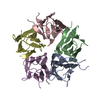
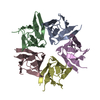
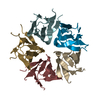

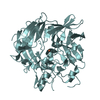


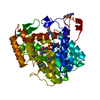
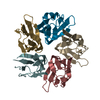

 PDBj
PDBj


